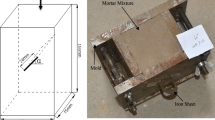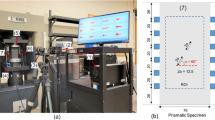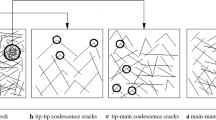Abstract
The cracks in a rock tend to initiate, propagate, and coalesce under loading. Based on the digital image correlation (DIC) method, uniaxial compression tests are carried out on rock-like specimens with various arrangements of two parallel cracks. The full-field strain and failure features of the rock-like materials are observed and analysis by a self-developed code. Two process zones are defined according to the differences between the shear strain field and the tensile strain field: a shear process zone and a tensile process zone. The following results are obtained in this study. (1) Three coalescence modes can be observed using the DIC method: a shear coalescence mode, a tensile coalescence mode, and a mixed coalescence mode. (2) At the microscopic level, the bridge angle and crack arrangement affect the formation of the process zone; at the macroscopic level, they determine the crack propagation path and the failure mode. (3) The peak strength of the rock-like specimen is related to the crack inclination angle and the bridge angle. (4) Numerical modeling by the expanded distinct element method and the strain strength criterion simulates the different coalescence modes of the experimental study efficiently.
























Similar content being viewed by others
Abbreviations
- α :
-
Crack inclination angle
- β :
-
Bridge angle
- \({\varepsilon _t}\) :
-
Critical tensile strain
- \({\gamma _{xy{\text{cri}}}}\) :
-
Critical shear strain
- \({\sigma _t}\) :
-
Critical tensile strength
- \({\sigma _{\text{c}}}\) :
-
Critical compressive strength
- \({\sigma _1},{\sigma _3}\) :
-
Maximum and minimum principal stresses, respectively
- \(\nu\) :
-
Poisson’s ratio
- \(\varphi\) :
-
Internal friction angle
- c :
-
Cohesion
- C :
-
Correlation coefficient
- E :
-
Young’s modulus
- G :
-
Shear modulus
- \({f_{1m}},{f_{2m}}\) :
-
Average gray values of the reference and deformed images, respectively
- \({f_1}(x,y),{f_2}(x',y')\) :
-
Gray-level values for the reference and deformed images, respectively
- \({f_{\text{t}}},{f_{\text{s}}}\) :
-
Judgement factors of the tensile and shear cracks, respectively
- BPM:
-
Bonded-particle model
- DDM:
-
Displacement discontinuity method
- DEM:
-
Discrete element method
- DIC:
-
Digital image correlation
- EDEM:
-
Expanded distinct element method
- LEFM:
-
Linear elastic fracture mechanics
- PFC:
-
Particle flow code
- SIF:
-
Stress intensity factor
- SPZ:
-
Shear process zone
- TPZ:
-
Tensile process zone
- UDEC:
-
Universal distinct element code
References
Bobet A, Einstein HH (1998a) Fracture coalescence in rock-type materials under uniaxial and biaxial compression. Int J Rock Mech Min Sci 35(7):863–888. https://doi.org/10.1016/S0148-9062(98)00005-9
Bobet A, Einstein HH (1998b) Numerical modeling of fracture coalescence in a model rock material. Int J Fract 92(33):221–252. https://doi.org/10.1023/A:1007460316400
Brace WF, Bombolakis EG (1963) A note on brittle crack growth in compression. J Geophys Res 68(12):3709–3713
Chan HCM (1986) Automatic two-dimensional multi-fracture propagation modelling of brittle solids with particular application to rock. Dissertation, Massachusetts Institute of Technology
Cho N, Martin CD, Sego DC (2007) A clumped particle model for rock. Int J Rock Mech Min Sci 44(7):997–1010
Dugdale DS (1960) Yielding of steel sheets containing slits. J Mech Phys Solids 8(2):100–104. https://doi.org/10.1016/0022-5096(60)90013-2
Goncalves da Silva B, Einstein HH (2013) Modeling of crack initiation, propagation and coalescence in rocks. Int J Fract 182(2):167–186. https://doi.org/10.1007/s10704-013-9866-8
Griffith AA (1921) The phenomena of rupture and flow in solids. Philos Trans R Soc 221(582–593):163–198
Haeri H, Shahriar K, Marji MF, Moarefvand P (2014a) On the strength and crack propagation process of the pre-cracked rock-like specimens under uniaxial compression. Strength Mater 46(1):140–152. https://doi.org/10.1007/s11223-014-9525-y
Haeri H, Shahriar K, Marji MF, Moarefvand P (2014b) Experimental and numerical study of crack propagation and coalescence in pre-cracked rock-like disks. Int J Rock Mech Min Sci 67:20–28. https://doi.org/10.1016/j.ijrmms.2014.01.008
Hoek E, Bieniawski ZT (1965) Brittle fracture propagation in rock under compression. Int J Fract 1(3):137–155
Horii H, Nematnasser S (1985) Compression-induced microcrack growth in brittle solids: axial splitting and shear failure. J Geophys Res Sol Earth 90(NB4):3105–3125. https://doi.org/10.1029/JB090iB04p03105
Irwin GR (1957) Relation of stresses near a crack to the crack extension force. 9th International congress of applied mechanics, Brussels, pp 245–251
Jiang YJ, Li B, Yamashita Y (2009) Simulation of cracking near a large underground cavern in a discontinuous rock mass using the expanded distinct element method. Int J Rock Mech Min Sci 46(1):97–106. https://doi.org/10.1016/j.ijrmms.2008.05.004
Kranz RL (1983) Microcracks in rocks—a review. Tectonophysics 100(1–3):449–480. https://doi.org/10.1016/0040-1951(83)90198-1
Lajtai EZ (1974) Brittle fracture in compression. Int J Fract 10(4):525–536
Lan H, Martin CD, Hu B (2010) Effect of heterogeneity of brittle rock on micromechanical extensile behavior during compression loading. J Geophy Res 115:B01202. https://doi.org/10.1029/2009JB006496
Lee H, Jeon S (2011) An experimental and numerical study of fracture coalescence in pre-cracked specimens under uniaxial compression. Int J Solids Struct 48(6):979–999. https://doi.org/10.1016/j.ijsolstr.2010.12.001
Li JC, Ma GW (2009) Experimental study of stress wave propagation across a filled rock joint. Int J Rock Mech Min Sci 46(3):471–478. https://doi.org/10.1016/j.ijrmms.2008.11.006
Li HQ, Wong LNY (2014) Numerical study on coalescence of pre-existing flaw pairs in rock-like material. Rock Mech Rock Eng 47(6):2087–2105. https://doi.org/10.1007/s00603-013-0504-6
Li JC, Ma GW, Zhao J (2010) An equivalent viscoelastic model for rock mass with parallel joints. J Geophys Res Sol Earth. https://doi.org/10.1029/2008JB006241
Pan B, Qian KM, Xie HM, Asundi A (2009) Two-dimensional digital image correlation for in-plane displacement and strain measurement: a review. Meas Sci Technol. https://doi.org/10.1088/0957-0233/20/6/062001
Park CH, Bobet A (2009) Crack coalescence in specimens with open and closed flaws: a comparison. Int J Rock Mech Min Sci 46(5):819–829. https://doi.org/10.1016/j.ijrmms.2009.02.006
Park CH, Bobet A (2010) Crack initiation, propagation and coalescence from frictional flaws in uniaxial compression. Eng Fract Mech 77(14):2727–2748. https://doi.org/10.1016/j.engfracmech.2010.06.027
Peters WH, Ranson WF (1982) Digital imaging techniques in experimental stress-analysis. Opt Eng 21(3):427–431. https://doi.org/10.1117/12.7972925
Petit JP, Barquins M (1988) Can natural faults propagate under mode II conditions. Tectonics 7(6):1243–1256. https://doi.org/10.1029/TC007i006p01243
Potyondy DO, Cundall PA (2004) A bonded-particle model for rock. Int J Rock Mech Min Sci 41(8):1329–1364
Reyes O, Einstein HH (1991) Failure mechanisms of fractured rock: a fracture coalescence model. 7th ISRM congress, Aachen, pp 333–340
Rice JR (1968) A path independent integral and the approximate analysis of strain concentration by notches and cracks. Int J Appl Mech 35(2):379–386. https://doi.org/10.1115/1.3601206
Sagong M, Bobet A (2002) Coalescence of multiple flaws in a rock-model material in uniaxial compression. Int J Rock Mech Min Sci 39(2):229–241. https://doi.org/10.1016/S1365-1609(02)00027-8
Shen BT, Stephansson O, Einstein HH, Ghahreman B (1995) Coalescence of fractures under shear stresses in experiments. J Geophys Res Sol Earth 100(B4):5975–5990. https://doi.org/10.1029/95JB00040
Tang CA, Lin P, Wong RHC et al (2001) Analysis of crack coalescence in rock-like materials containing three flaws-part 2: numerical approach. Int J Rock Mech Min 38:925–939
Wong RHC, Chau KT (1998) Crack coalescence in a rock-like material containing two cracks. Int J Rock Mech Min Sci 35(2):147–164. https://doi.org/10.1016/S0148-9062(97)00303-3
Wong LNY, Einstein HH (2006) Fracturing behavior of prismatic specimens containing single flaws. In: Proceedings of the 41st US symposium on rock mechanics, Golden, Colorado, ARMA/USRMS 06-899
Wong LNY, Einstein HH (2009a) Systematic evaluation of cracking behavior in specimens containing single flaws under uniaxial compression. Int J Rock Mech Min Sci 46(2):239–249. https://doi.org/10.1016/j.ijrmms.2008.03.006
Wong LNY, Einstein HH (2009b) Crack coalescence in molded gypsum and carrara marble: Part 1 macroscopic observations and interpretation. Rock Mech Rock Eng 42(3):475–511. https://doi.org/10.1007/s00603-008-0002-4
Wong LNY, Einstein HH (2009c) Crack coalescence in molded gypsum and carrara marble: Part 2 microscopic observations and interpretation. Rock Mech Rock Eng 42(3):513–545. https://doi.org/10.1007/s00603-008-0003-3
Wong LNY, Li HQ (2013) Numerical study on coalescence of two coplanar pre-existing flaws in rock. Int J Solids Struct 50:3685–3706. https://doi.org/10.1016/j.ijsolstr.2013.07.010
Wong RHC, Chau KT, Tang CA, Lin P (2001) Analysis of crack coalescence in rock-like materials containing three flaws—Part I: experimental approach. Int J Rock Mech Min Sci 38(7):909–924. https://doi.org/10.1016/S1365-1609(01)00064-8
Yang L, Jiang YJ, Li SC, Li B (2013) Experimental and numerical research on 3D crack growth in rocklike material subjected to uniaxial tension. J Geotech Geoenviron 139(10):1781–1788. https://doi.org/10.1061/(ASCE)GT.1943-5606.0000917
Zhang XP, Wong LNY (2012) Cracking processes in rock-like material containing a single flaw under uniaxial compression: a numerical study based on parallel bonded-particle model approach. Rock Mech Rock Eng 45:711–737
Zhang XP, Wong LNY (2013) Crack initiation, propagation and coalescence in rock-like material containing two flaws: a numerical study based on bonded-particle model approach. Rock Mech Rock Eng 46(5):1001–1021
Zhang XP, Wong LNY (2014) Displacement field analysis for cracking processes in bonded-particle model. Bull Eng Geol Environ 73:13–21
Zhang H, Song HP, Kang YL, Huang GY, Qu CY (2013) Experimental analysis on deformation evolution and crack propagation of rock under cyclic indentation. Rock Mech Rock Eng 46(5):1053–1059. https://doi.org/10.1007/s00603-012-0309-z
Zhang XP, Zhang Q, Wu SC (2017) Acoustic emission characteristics of the rock-like material containing a single flaw under different compressive loading rates. Comput Geotech 83:83–97
Zhao C, Matsuda H, Morita C, Shen MR (2011) Study on failure characteristic of rock-like materials with an open-hole under uniaxial compression. Strain 47(5):405–413. https://doi.org/10.1111/j.1475-1305.2009.00701.x
Zhao C, Bao C, Matsuda et al (2015) Application of digital image correlation method in experimental research on crack propagation of brittle rock. China J Geol Eng 37(5):944–951 (in Chinese)
Zhao YL, Zhang LY, Wang WJ, Pu CZ, Wan W, Tang JZ (2016) Cracking and stress-strain behavior of rock-like material containing two flaws under uniaxial compression. Rock Mech Rock Eng 49(7):2665–2687. https://doi.org/10.1007/s00603-016-0932-1
Zhao C, Ma CC, Zhao CF, Du SG, Bao C (2017) Crack propagation simulation of rock-like specimen using strain criterion. Eup J Environ Civ Eng. https://doi.org/10.1080/19648189.2017.1359677
Acknowledgements
The authors would like to acknowledge the financial support of the National Key R&D Program of China (no. 2017YFC0806000), the National Natural Science Foundation of China (nos. 41202193 and 41572262), the Innovation Program of the Shanghai Municipal Education Commission (no. 15ZZ016), and the Shanghai Rising-Star Program (no. 17QC1400600).
Author information
Authors and Affiliations
Corresponding author
Ethics declarations
Conflict of interest
No potential conflicts of interests were reported by the authors.
Additional information
Publisher’s Note
Springer Nature remains neutral with regard to jurisdictional claims in published maps and institutional affiliations.
Rights and permissions
About this article
Cite this article
Zhao, C., Zhou, Y.m., Zhao, C.f. et al. Cracking Processes and Coalescence Modes in Rock-Like Specimens with Two Parallel Pre-existing Cracks. Rock Mech Rock Eng 51, 3377–3393 (2018). https://doi.org/10.1007/s00603-018-1525-y
Received:
Accepted:
Published:
Issue Date:
DOI: https://doi.org/10.1007/s00603-018-1525-y




